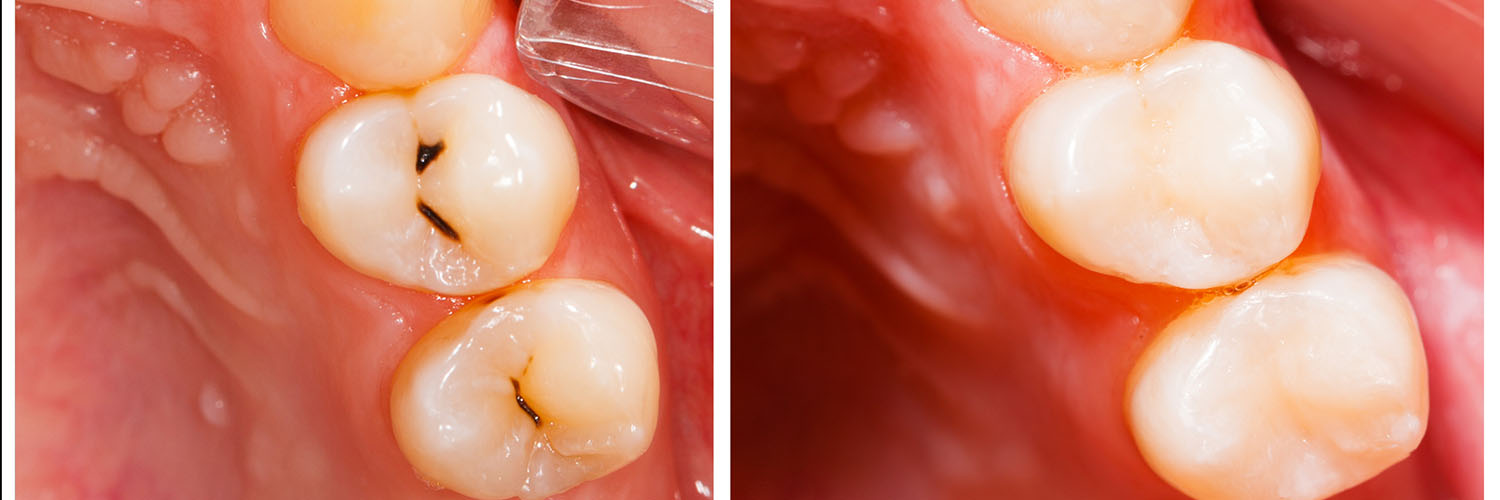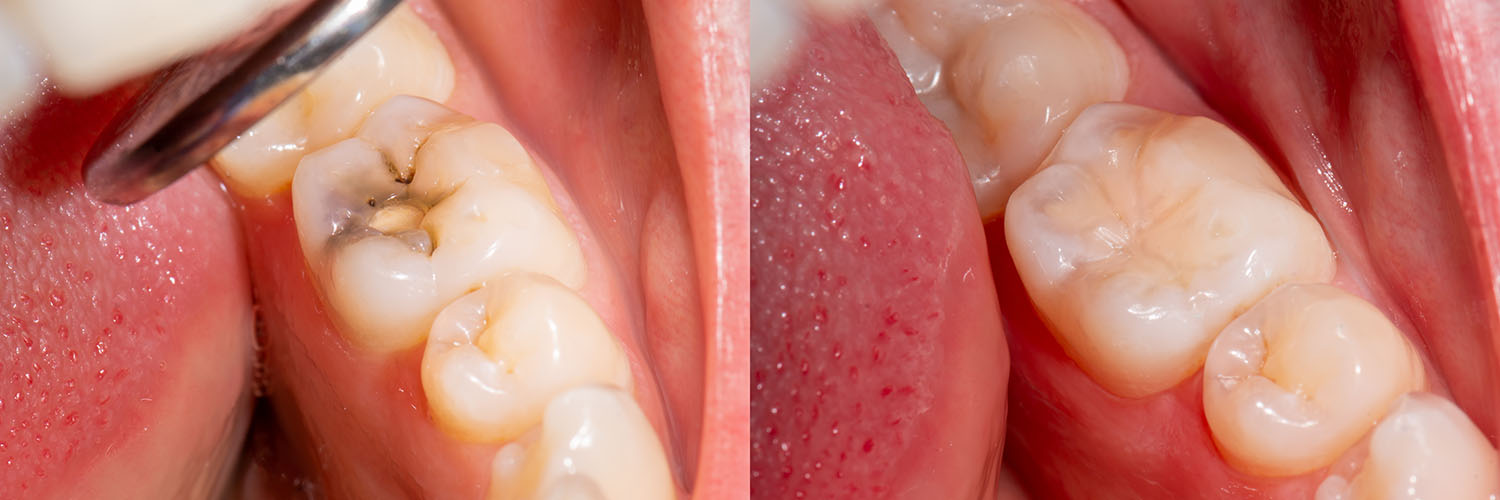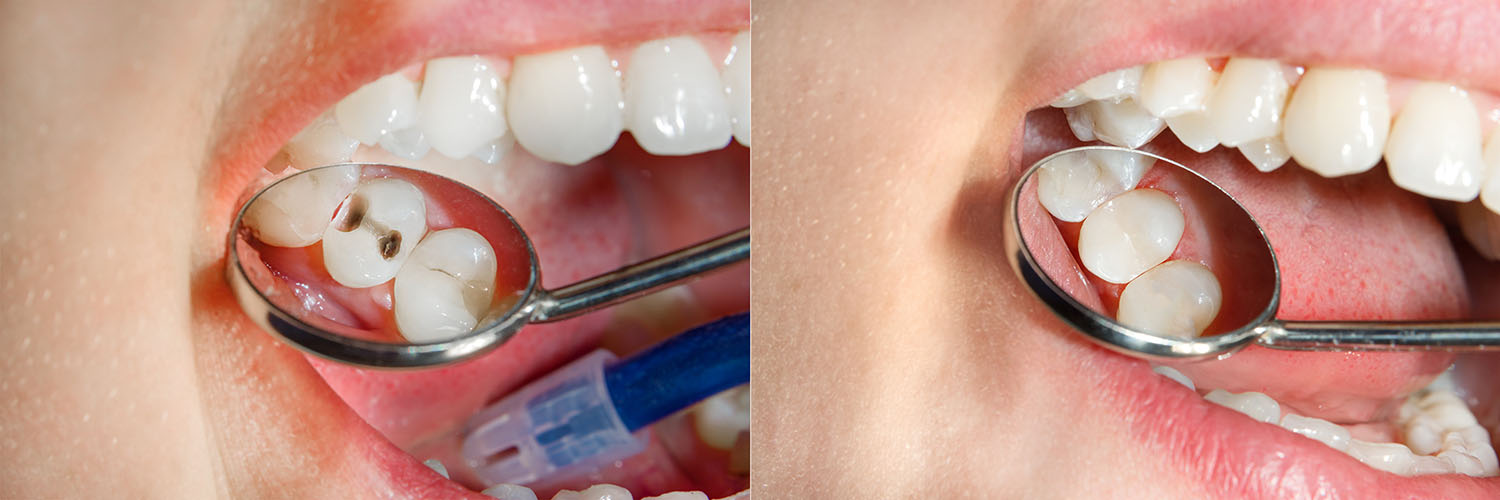
When a tooth’s structure is weakened by decay or damage, a dental filling rebuilds what’s been lost so the tooth can work normally again. Fillings restore chewing surfaces, reestablish contact with neighboring teeth, and protect the inner layers of the tooth from bacteria and further breakdown.
Modern restorative dentistry treats fillings as more than a functional repair — they are also an opportunity to preserve natural tooth structure and maintain an attractive smile. Materials and techniques used today are designed to blend with your teeth while providing the durability necessary for everyday use.
Our team focuses on minimally invasive preparation and careful material selection to get predictable, long-lasting outcomes. The office of Dr. Aaron Tropmann & Dr. Gary Oyster emphasizes precision and patient comfort so you leave with a restoration that looks and feels right.
People have tried to repair damaged teeth for thousands of years; archaeological digs reveal primitive restorations long before modern dentistry existed. Over time, materials evolved from natural substances to metals, and more recently to tooth-colored options that prioritize both function and cosmetics.
The 19th and 20th centuries brought durable metallic restoratives that served patients well for many decades. More recently, advances in adhesive dentistry and ceramic technologies have delivered alternatives that are mercury-free, metal-free, and much better at matching tooth color and translucency.
These developments allow clinicians to choose solutions tailored to the location and extent of the defect, the patient’s aesthetic priorities, and the long-term health of the tooth. Selecting the right material always balances longevity, strength, and appearance.
We approach every restoration with the goal of preserving as much healthy tooth as possible while eliminating decay and staining that can compromise the area. Decisions about preparation, bonding, and occlusal adjustment are driven by clinical assessment and the patient’s preferences.
Beyond the filling itself, we consider how the restored tooth interacts with the bite and neighboring teeth. Proper shaping and polishing reduce wear on opposing teeth and help prevent food traps or plaque buildup that can lead to future problems.
When appropriate, we explain options such as composite resins, glass ionomer cements, ceramic inlays/onlays, and other restorative choices so patients understand the benefits and limitations of each approach.

Not all fillings are the same. The best choice depends on the location of the cavity, the amount of remaining tooth, aesthetic expectations, and the functional demands placed on the restoration. For example, a small front-tooth repair calls for a different approach than a large chewing-surface restoration on a molar.
Contemporary restorative options range from directly placed resins to indirect porcelain or gold restorations fabricated outside the mouth. Each category has advantages — some emphasize appearance, others prioritize wear resistance and longevity.
Our clinicians review the practical considerations for each material and recommend solutions that align with your goals while protecting the tooth. Where appropriate, we describe the trade-offs so you can make an informed decision about your care.
Composite fillings are made from a resin matrix combined with small glass fillers to create a strong, visually pleasing restoration. They are shaded to match your tooth and bond directly to enamel and dentin, which can strengthen the remaining structure and minimize the amount of healthy tooth that must be removed.
Because composites are placed and shaped intraorally, they allow the dentist to restore contour and function in a single visit. Over time, they may require maintenance or replacement, especially in high‑stress areas, but their aesthetic and conservative qualities make them a popular choice.
Amalgam has a long history as a reliable, wear‑resistant material for restoring teeth subjected to heavy chewing forces. While not tooth‑colored, amalgam remains a durable option for certain posterior restorations where strength is the primary concern.
When used, amalgam is placed with careful attention to preparation design and occlusal contact to ensure lasting performance.
Glass ionomer materials bond chemically to tooth structure and gradually release fluoride, which can help protect the treated tooth from future decay. They work well for small restorations, areas near the gumline, and as a provisional or pediatric solution.
Because they are less resistant to long‑term wear than some alternatives, glass ionomers are often chosen for low‑stress sites or temporary restorations until a more durable option can be placed.
Ceramic restorations are fabricated in a dental laboratory or milled in‑office from high‑strength porcelain. They offer exceptional aesthetics and wear resistance and are an excellent choice when a larger portion of the tooth needs rebuilding, but a full crown is not necessary.
Because they are made outside the mouth, ceramic inlays and onlays require precise impressions or digital scans and a second appointment for cementation, but they often provide superior long‑term color stability and strength.
Gold restorations are less common today but remain highly regarded for their durability and tissue‑friendly properties. When longevity and precise fit are the priority, gold inlays or onlays can be an excellent option; however, they are typically chosen for specific situations where their advantages outweigh aesthetic considerations.

After we evaluate your smile and confirm the presence and extent of decay, we’ll outline the most appropriate treatment plan and explain the steps involved. Our goal is to restore the tooth efficiently while keeping you comfortable and informed throughout the process.
Most fillings are placed during a single appointment. The tooth is isolated and numbed so you won’t feel pain during the procedure. Decayed tissue is removed using rotary instruments, lasers, or air abrasion depending on the location and the clinician’s judgment, then the tooth is prepared to receive the chosen material.
For direct restorations like composites or glass ionomers, the material is placed and shaped immediately. For indirect solutions such as ceramic inlays, impressions or scans are taken and a temporary restoration may be used while the final piece is fabricated. Throughout, we verify the bite and make fine adjustments so the restoration integrates smoothly with your natural function.
For patients who experience anxiety, we discuss comfort options and calming techniques. Local anesthesia is commonly used and is highly effective at eliminating discomfort during treatment. Sedation options are available in our practice for those who need extra support.
Caring for a restored tooth is largely the same as caring for your natural teeth: a consistent routine of brushing, flossing, and regular dental checkups will help your fillings last. Proper oral hygiene reduces the risk of new decay at the margins of a restoration.
Immediately after a filling, minor sensitivity or a different feeling when you bite is common. These sensations typically resolve within days to a few weeks. If discomfort persists or if you notice a sharp or prolonged pain, contact the office so we can assess whether an adjustment is needed.
With reasonable home care and routine professional exams, most restorations perform well for many years. If the surrounding tooth structure changes due to new decay or fracture, additional treatment may be recommended to preserve the tooth long term.
Protect yourself while numb
After your appointment you may still be numb for a short time. Avoid chewing on the treated side and be cautious with hot drinks until normal sensation returns to prevent accidental biting or soft‑tissue injury.
Expect a brief settling period
It’s normal for a newly restored tooth to feel slightly different at first. If you sense high spots or uneven contact when biting, let us know so we can make precise adjustments for comfort and function.
Short‑term sensitivity is common
Sensitivity to temperature or pressure after a filling is usually temporary. If it becomes more intense or does not improve, call our office so we can determine whether further treatment is needed.
Maintain your restoration with routine care
Fillings are durable, but they aren’t indestructible. Regular brushing, flossing, and professional cleanings help prevent recurrent decay and extend the useful life of your restorations.
We aim to provide thoughtful, evidence‑based care that preserves your natural teeth and supports long‑term oral health.

Dental fillings remain a fundamental, effective way to repair teeth affected by decay or minor damage. With modern materials and careful techniques, restorations can preserve tooth structure, restore function, and maintain an attractive appearance for many years.
If you have questions about the types of fillings available, how a particular material performs, or what to expect during treatment, the team at the office of Dr. Aaron Tropmann & Dr. Gary Oyster is available to help you make an informed choice.
Contact us for more information or to schedule an evaluation so we can recommend the option that best supports your oral health and smile goals.

Dental fillings repair teeth that have been weakened by decay or minor damage by rebuilding lost structure so the tooth can function normally. They restore chewing surfaces, reestablish contact with neighboring teeth, and seal off inner tooth layers from bacteria that can cause further breakdown. Modern fillings also aim to preserve as much healthy tooth structure as possible while providing a stable surface for biting and chewing.
Fillings can be placed directly in the mouth during a single appointment or fabricated outside the mouth for larger repairs. The choice of technique and material affects the appearance, strength, and longevity of the restoration. Your clinician will recommend an approach that balances function, conservation of tooth structure, and aesthetic expectations.
Common filling materials include tooth-colored composite resins, glass ionomer cements, amalgam, ceramic inlays/onlays, and metal alloys such as gold. Composite resins bond to enamel and dentin and are shaded to match tooth color, making them a conservative and aesthetic choice for many repairs. Glass ionomer cements chemically adhere to tooth structure and release fluoride, which can be beneficial in low‑stress or pediatric applications.
Amalgam has a long history of durability for posterior teeth subjected to heavy chewing forces, though it is not tooth‑colored. Ceramic inlays and onlays are fabricated outside the mouth and offer excellent color stability and wear resistance for larger defects when a full crown is not needed. Metal alloys like gold remain valued for precise fit and longevity in select clinical situations where function outweighs aesthetics.
Each material carries trade-offs among appearance, wear resistance, biocompatibility, and how much healthy tooth must be removed during preparation. Your dentist will review these factors when recommending a material so you understand the benefits and limitations of each option. Advances in adhesive and ceramic technologies have broadened choices that are mercury‑free and metal‑free for patients who prefer those alternatives.
Material selection depends on the location and size of the defect, the amount of remaining healthy tooth, the forces the tooth must withstand, and your aesthetic priorities. Small anterior repairs often favor tooth‑colored composites for their visual match, while large posterior restorations may call for an indirect ceramic or metal solution to better resist chewing forces. The overall health of the tooth, presence of moisture control, and potential for recurrent decay also influence the choice.
Clinicians balance longevity, conservation of tooth structure, and patient preferences when recommending a material. They will explain practical considerations, such as whether an indirect restoration requires multiple visits or whether a direct material can be placed immediately. This discussion helps you make an informed decision that aligns with your oral health goals and lifestyle.
After a clinical exam and any necessary X‑rays, the tooth is isolated and numbed so you remain comfortable throughout the procedure. Decayed or damaged tissue is removed using rotary instruments, air abrasion, or lasers depending on the location and clinical judgment, and the tooth is prepared to receive the chosen material. For direct restorations such as composites, the material is placed, contoured, and polished in the same visit to restore form and function.
For indirect restorations like ceramic inlays or onlays, impressions or digital scans are taken and a temporary restoration may be used while the final piece is fabricated. The final restoration is then cemented or bonded and the bite is checked and adjusted to integrate smoothly with neighboring teeth. At the office of Dr. Aaron Tropmann & Dr. Gary Oyster, clinicians emphasize precision and patient comfort so restorations look and feel natural.
Local anesthesia is commonly used to eliminate discomfort during the procedure, and most patients experience little to no pain while the filling is being placed. Some people may feel pressure or vibration from instruments, but the numbing medication prevents sharp pain during treatment. For patients with anxiety, additional comfort measures or sedation options can be discussed with the dental team.
After the numbing wears off, it is normal to experience mild sensitivity to temperature or pressure for a few days to a few weeks. This short‑term sensitivity typically resolves as the tooth adapts to the restoration; however, if you experience persistent, sharp, or worsening pain you should contact the office so the clinician can evaluate the restoration and determine whether an adjustment or further treatment is needed.
The lifespan of a filling depends on the material used, the size and location of the restoration, oral hygiene habits, and functional stresses such as grinding or heavy chewing. Composite fillings in low‑stress areas may last many years but can require maintenance or replacement sooner in high‑wear zones. Indirect restorations such as ceramic inlays or gold onlays often offer superior longevity when properly designed and maintained.
Regular dental checkups and good home care—brushing, flossing, and addressing habits like clenching—help extend the useful life of a restoration. Recurrent decay at the margins, fracture of the remaining tooth, or wear of the filling are common reasons a restoration may need repair or replacement. Your dentist will monitor restorations during routine exams and recommend appropriate follow‑up when changes are detected.
Timely intervention when problems arise preserves tooth structure and can prevent the need for more complex treatments such as crowns or root canals. Maintaining a discussion with your dental team about expectations for longevity based on material and function helps set realistic goals for ongoing care.
Caring for a restored tooth mirrors caring for natural teeth: consistent brushing twice daily with fluoride toothpaste, daily flossing, and routine professional cleanings reduce the risk of recurrent decay around a filling. Avoiding hard or excessively sticky foods shortly after treatment helps protect a new restoration while any bonding materials fully set. If you grind your teeth, wearing a night guard can reduce excessive wear on fillings and opposing teeth.
Be mindful while the local anesthetic wears off to avoid accidentally biting your cheek, lip, or tongue. Report any persistent sensitivity, roughness, or uneven bite so the dentist can make precise adjustments. Regular dental visits allow the team to assess the condition of restorations and provide preventive care that extends their service life.
Signs that a filling may be failing include new or increasing sensitivity to hot, cold, or sweet stimuli, persistent pain when biting, visible cracks or chips in the restoration, or dark lines or staining at the filling margins. Sometimes recurrent decay develops beneath or alongside a filling without obvious symptoms, which is why radiographic and clinical exams at regular checkups are important. A loose or missing filling is an urgent issue because it can expose the inner tooth to bacteria and lead to more extensive damage.
If you notice any of these signs, contact the dental office for an evaluation so the team can determine the cause and recommend appropriate treatment. Early assessment often allows for a less invasive repair and helps preserve the remaining tooth structure. Maintaining scheduled dental visits is the best way to detect subtle changes before they become more serious.
Inlays and onlays or full crowns are typically recommended when a large portion of the tooth is compromised and a direct filling would not provide sufficient strength or sealing. Indirect restorations are fabricated outside the mouth to precisely rebuild missing tooth structure and distribute biting forces more effectively for teeth with extensive damage or fracture. Choosing an inlay, onlay, or crown helps protect the tooth long term and can reduce the risk of future breakdown compared with a large direct restoration.
The decision considers factors such as remaining tooth structure, occlusal forces, aesthetic needs, and whether the tooth has undergone previous restorations or endodontic treatment. Your clinician will explain why a conservative indirect restoration may be preferable to repeatedly replacing large fillings, and how each option supports tooth preservation. Digital scans or impressions and careful planning ensure the restoration fits accurately and functions harmoniously within the bite.
For children, choices often prioritize materials and techniques that are quick, durable, and accommodate cooperation during treatment; glass ionomer cements are commonly used for their fluoride release and ability to bond in moist environments, while composites are selected when aesthetics and conservation are a priority. Behavioral management, the size of the lesion, and the child’s risk of future decay all influence material selection and timing of treatment. Pediatric restorations may also be designed as interim solutions when a permanent restoration can be placed later.
Patients with sensitive teeth or specific medical considerations may require modified protocols such as desensitizing agents, careful anesthesia planning, or alternative materials to reduce postoperative discomfort. The practice of Dr. Aaron Tropmann & Dr. Gary Oyster emphasizes individualized treatment planning and discusses comfort strategies and material options tailored to each patient’s needs. Clear communication about expectations and follow‑up helps ensure successful outcomes across age groups and clinical situations.
In all cases, preventive measures—fluoride, sealants where appropriate, and consistent home care—reduce the likelihood of new decay and the need for restorations. Regular dental visits allow the team to monitor developing concerns early and recommend minimally invasive interventions when possible.

Ready to book your next appointment or have a question for our team? We're here to help.
Connecting with our team is simple! Our friendly staff is here to help with appointment scheduling, answer any questions about your treatment options, and address any concerns you may have. Whether you prefer to give us a call, send an email, or fill out our convenient online contact form, we’re ready to assist you. Take the first step toward a healthier, brighter smile – reach out to us today and experience the difference compassionate, personalized dental care can make.